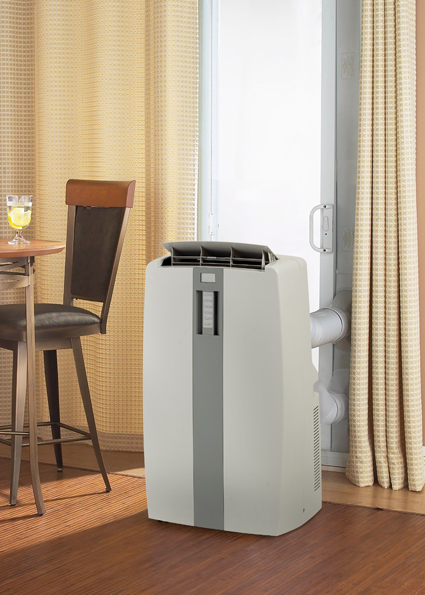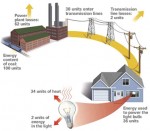
When it comes to summer time and the need to find ways in which to stay cool without killing our budgets or wiping out the ozone layer, one of the easiest ways to do this lies in properly outfitting our homes with the right AC. By re-considering central AC systems and opting for evaporative coolers and portable air conditioners, more and more families are finding that they don’t mind sticking to one or two rooms in light of the benefits.
These smaller options make it easy to cool just one or two high traffic rooms, as opposed to the entire house. And, not only is less energy used at one time, these can be turned off and on rapidly, making sure they are used only as needed just until room reaches optimum temperature. Less energy plus lower cost makes these very smart options for many households.
However, without the proper knowledge, searching for a portable air conditioner can become an overwhelming experience. Between trying to figure out a plethora of acronyms like EER and BTU and wading through numbers all over the 1,000s, the confusion can multiply. But, with a basic foundation, a confusing and/or time consuming experience can quickly become a simple formula that leaves you lingering in the comfort and bliss of a perfectly cooled and de-humidified room. And not only that, purchasing the right AC, the first time, will save you now and over the long run.
Basic AC Terms
“W” – A “W” is a watt, which is the standard unit for measuring power.
“BTU” – A BTU stands for British Thermal Unit and measures thermal heat energy. In terms of ACs, they will generally rank in the 1000s.
“EER” – EER stands for the Energy Efficiency Ratio of any given appliance and basically tell you exactly how much cooling your AC will be able to provide you based on the amount of electricity it’s using. The higher the EER rating, the less energy it consumes. As a basic rule, anything over 10 is deemed “good” in terms of energy efficiency.
You will often see “energy consumed” represented by a “W,” and EERs can also be listed as BTU/W.
This means if you have two ACs, “A” vs. “B” and both have a BTU of 10,000, but “A” has a 1,000 W rate and “B” has a 1,500 W rate, you can simply divide 10,000 by 1,000 and 1,500 respectively, to figure out the EER. Thus, “A” would have an EER of 10, and “B” would have an EER of 6.6, making unit “A” the better choice in terms of energy consumption. Note that you will typically have to pay for the higher EER ranking, but should save money over the long run.
“SEER” – The SEER takes things to the final step and tells you the Seasonal Energy Efficiency Ratio, which is determined by BTU divided by watts within in a given cooling season. As with EER, the higher the SEER, the more energy efficient the AC is.
Basic Formula
Now, with the right terminology in mind, you can follow a simple guideline to figure out just how many BTUs you need. This is important, because if you have too few BTUs, your room will not be properly cooled off. (Which basically means you’d be paying to run something and seeing none of the potential benefits you could have if you had the proper size.) If you have too many BTUs, your AC will cycle off too quickly, which means that the room will be very chilled but not properly dehumidified, making for a cold, damp room that few would want to spend any time in. So, guarantee your room is cooled properly by following this easy guideline:
10,000 BTUs – 250 square feet
12,000 BTUs – 350 square feet
14,000 BTUs – 450 square feet.
It’s really as easy as starting by measuring your room and multiplying length by width. If you’ve got a 20 foot by 20 foot room, you’re looking at 400 square ft. and are going to need an AC with BTUs between 12,000 and 14,000.
That Simple
It’s truly as simple as that. One portable air conditioner can cool up to 450 square feet, giving you ample room to live and breathe, without having to cough up the installation cost of a central air system and then pay to cool an entire house (the guest bedroom?) that will be wasted cooling a large portion of the time.
The Perks
Don’t mess around with buying/trying/returning. You’ll lose money, almost guaranteed. Measure properly and buy the proper size the first time, without getting swindled by an AC dealer dead-set on selling you the biggest and best. And, when you aren’t paying to over cool or trying to compensate for an under-cooled room, you’ll continue to save and cut down your costs for the duration of use.
AUTHOR: Jocelyn Anne writes most frequently about encouraging families to living more affordable, environmentally friendly lifestyles. She’s currently writing for Air-n-Water about using a portable air conditioner to replace central AC systems to cut cost and energy use.

 Announcing: Green Energy Match – We’re So Close!
Announcing: Green Energy Match – We’re So Close! Where 98% of Energy Vanishes Before it Reaches Your Light Bulb?
Where 98% of Energy Vanishes Before it Reaches Your Light Bulb? Why We Need to Redefine Green Building into 4 Easy to Understand Elements
Why We Need to Redefine Green Building into 4 Easy to Understand Elements